
Clones is a small town in the west of County Monaghan in Ireland. The area is part of the Border Region in the Republic of Ireland, earmarked for economic development by the Irish Government due to its currently below-average economic situation. The town was badly hit economically by the Partition of Ireland in 1921 because of its location on the border with County Fermanagh in Northern Ireland. The creation of the Irish border deprived it of access to a large part of its economic hinterland for many years. The town had a population of 1,680 at the 2016 census. The town is in a civil parish of the same name.

Monaghan is the county town of County Monaghan, Ireland. It also provides the name of its civil parish and Monaghan barony.

The Sessions House at Usk, Wales, is a Victorian courthouse by Thomas Henry Wyatt of 1877. It is a Grade II* listed building as of 4 January 1974.
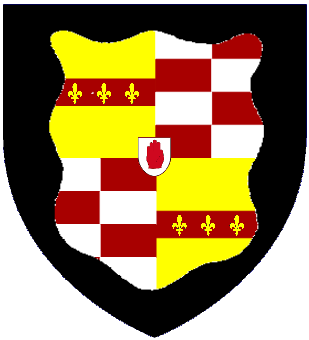
The Barrett-Lennard Baronetcy, of Belhus in the County of Essex, is a title in the Baronetage of the United Kingdom. It was created on 30 June 1801 for Thomas Barrett-Lennard, subsequently Member of Parliament for Essex South. He was the illegitimate son and testamentary heir of Thomas Barrett-Lennard, 17th Baron Dacre. He was succeeded by his grandson, the second Baronet, the son of Thomas Barrett-Lennard, Member of Parliament for Maldon. His son, the third Baronet, was childless and was succeeded by his younger brother, the fourth Baronet. This line of the family failed on the death in 1977 of his son, the fifth Baronet, who died without male issue. The late Baronet was succeeded by his third cousin once removed, the sixth Baronet. He was the son of Sir Fiennes Cecil Arthur Barrett-Lennard, Chief Justice of Jamaica, son of Captain Thomas George Barrett-Lennard, son of the first marriage of George Barrett-Lennard, son of John Barrett-Lennard, second son of the first Baronet. The sixth Baronet was a Catholic clergyman. As of 2014 the title is held by his second cousin, the seventh Baronet, who succeeded in 2007. He is the grandson of Trenchard Barrett-Lennard, son of the aforementioned George Lennard-Barrett by his second marriage. As of 31 December 2013 the present Baronet has not successfully proven his succession and is therefore not on the Official Roll of the Baronetage, with the baronetcy considered vacant since 2007.
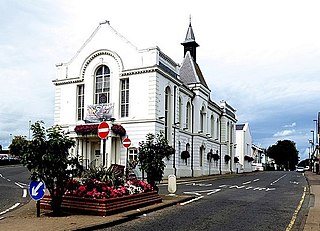
Ballymoney Town Hall is a municipal structure in the High Street, Ballymoney, County Antrim, Northern Ireland. The structure, which incorporates a local history museum, is a Grade B1 listed building.

Garstang Town Hall is a municipal building in the High Street in Garstang, Lancashire, England. The structure, which currently accommodates two shops and a Royal British Legion Club, is a Grade II listed building.
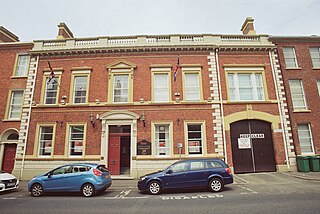
The Old Town Hall is a municipal structure in Castle Street, Lisburn, County Antrim, Northern Ireland. The structure, which is used as a constituency office by the Democratic Unionist Party, is a Grade B2 listed building.
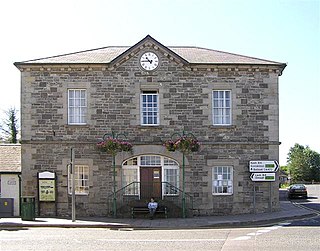
Ederney Town Hall, also styled as Ederney Townhall, is a municipal structure in Market Street, Ederney, County Fermanagh, Northern Ireland. The structure, which is used as a community events venue, is a Grade B1 listed building.

Wick Sheriff Court is a judicial structure in Bridge Street, Wick, Caithness, Scotland. The structure, which remains in use as a courthouse, is a Category B listed building.

Hamilton Sheriff Court is a judicial building in Almada Street, Hamilton, South Lanarkshire, Scotland. The building, which continues to serve as the local courthouse, is a Category A listed building.
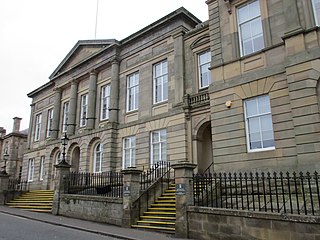
Lanark Sheriff Court is a judicial building in Hope Street, Lanark, South Lanarkshire, Scotland. The building, which continues to serve as the local courthouse, is a Category B listed building.

The Corn Hall is a commercial building in the Market Place, Cirencester, Gloucestershire, England. The structure, which is used as a shopping arcade and community events venue, is a Grade II listed building.

The Corn Exchange is a commercial building in the Market Place, Arbroath, Angus, Scotland. The structure, which is now used as a public house, is a Category B listed building.

The Tholsel is a municipal building in West Street, Drogheda, County Louth, Ireland. Formerly the meeting place of Drogheda Borough Council, it is currently used as a tourist information office.

Dundalk Town Hall, is a municipal building in Crowe Street, Dundalk, County Louth, Ireland. It currently accommodates the An Táin Arts Centre.

The Arch Building, previously known as Cobh Town Hall and before that as Queenstown Town Hall, is a municipal building in Casement Square, Cobh, County Cork, Ireland. The building currently accommodates a public library and a tourist information centre. It is included in Cork County Council's Record of Protected Structures.

Monaghan Town Hall, is a municipal building in Dublin Street, Monaghan, County Monaghan, Ireland. The building is currently used by Monaghan County Council as local municipal offices.

Castleblayney Town Hall is a municipal building in the Market Square at Castleblayney, County Monaghan, Ireland. It has served as a market house, as a town hall and as a courthouse, but is currently disused and standing derelict.
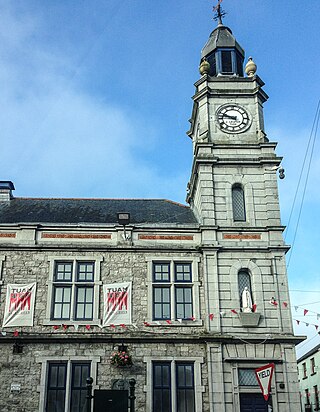
Tuam Town Hall is a municipal building in the Market Square at Tuam, County Galway, Ireland. It is currently used as a community events venue.

The Sessions House, formerly the Shire Hall, is a courthouse in Lynn Road, Ely, in the county of Cambridgeshire, England. The building, which is now used as the meeting place of the City of Ely Council, is a Grade II* listed building.





















